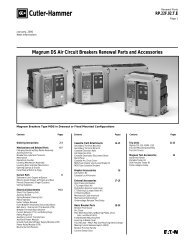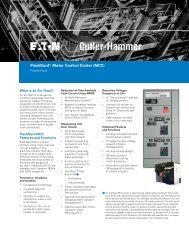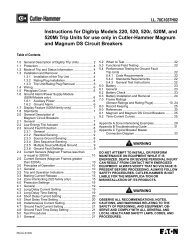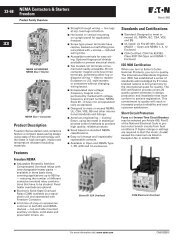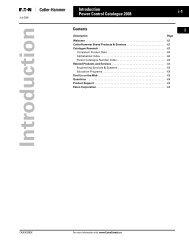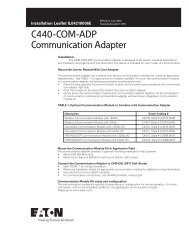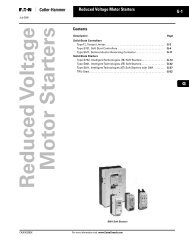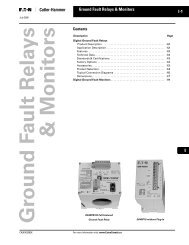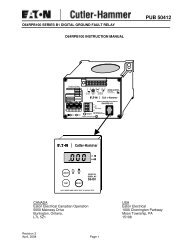M-Maxâ„¢ Series Adjustable Frequency Drive - Eaton Corporation
M-Maxâ„¢ Series Adjustable Frequency Drive - Eaton Corporation
M-Maxâ„¢ Series Adjustable Frequency Drive - Eaton Corporation
Create successful ePaper yourself
Turn your PDF publications into a flip-book with our unique Google optimized e-Paper software.
Operational Data Indicator (Operational)<br />
REF<br />
MON<br />
PAR<br />
FLT<br />
OK<br />
READY<br />
RUN STOP ALARM FAULT<br />
FWD REV I/O KEYPAD BUS<br />
The start release is done by actuating one of the digital inputs<br />
with +24V:<br />
● Terminal 8: FWD = Clockwise rotating field (Forward Run)<br />
● Terminal 9: REV = Counterclockwise rotating field<br />
(Reverse Run)<br />
The control commands are interlocked (exclusive OR) and<br />
require a rising voltage edge.<br />
The start release (FWD, REV) is shown in the top status line<br />
(LCD display) by the arrow ( ) switching from STOP to RUN.<br />
The frequency is shown with a minus sign with a start<br />
release with a left rotating field (REV).<br />
Operation (RUN) via Control Signal Terminal (I/O) with<br />
Left Rotating Field (REV) (for example, –12.34 Hz)<br />
REF<br />
MON<br />
PAR<br />
FLT<br />
READY<br />
Display in automatic alternation<br />
By actuating the OK button, you can set the display<br />
mode to stay on the value for the output frequency<br />
(0.00 Hz).<br />
RUN STOP ALARM FAULT<br />
FWD REV I/O KEYPAD BUS<br />
You can now set the output frequency (0–60 Hz) and<br />
therefore the speed of the connected AC motor (0–n motor )<br />
with the setpoint value potentiometer via terminal 2<br />
(proportional voltage signal 0–10V). The change in output<br />
frequency here is delayed based on the specified<br />
acceleration and deceleration ramps. In the factory settings,<br />
these times are set to 3 seconds.<br />
REF<br />
MON<br />
PAR<br />
FLT<br />
READY<br />
RUN STOP ALARM FAULT<br />
FWD REV I/O KEYPAD BUS<br />
Operation<br />
The stop command can also be given via the STOP<br />
button on the operating unit. The STOP button is<br />
active in all operating modes. It can be disabled with<br />
parameter (P6.16 = 0).<br />
A controlled run-down can be set using parameter P6.8<br />
(STOP function) (P6.8 = 1).<br />
The relevant deceleration time is set in parameter P6.6. The<br />
acceleration time are set in parameter P6.5.<br />
Information on settings and the description of the<br />
parameters used here are provided in “<strong>Drive</strong>s Control (P6)”<br />
on Page 80.<br />
The acceleration and deceleration ramps specify the<br />
time change for the output frequency: from zero to<br />
fmax (FS = 60 Hz) or from fmax back to zero.<br />
The figure on Page 52 shows a good example of the<br />
process, if the release signal (FWD/REV) is switched on and<br />
the maximum setpoint voltage (+10V) is applied. The speed<br />
of the motor follows the output frequency depending on the<br />
load and moment of inertia (slip), from zero to nmax .<br />
If the release signal (FWD, REV) is switched off during<br />
operation, the inverter is blocked immediately (STOP). The<br />
motor comes to an uncontrolled stop (see [1] in the figure on<br />
Page 52).<br />
M-Max <strong>Series</strong> <strong>Adjustable</strong> <strong>Frequency</strong> <strong>Drive</strong> MN04020003E—April 2011 www.eaton.com 51




